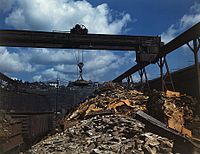
Photo from wikipedia
Abstract—The review presents the original experimental data on the structure formation and properties of titanium, aluminum, copper, and their alloys upon intense deformation and shock-wave conditions. The main volume of… Click to show full abstract
Abstract—The review presents the original experimental data on the structure formation and properties of titanium, aluminum, copper, and their alloys upon intense deformation and shock-wave conditions. The main volume of the article is devoted to the production of the submicrocrystalline and nanocrystalline non-ferrous metals and alloys by dynamic channel-angular pressing. The optimal regimes of DCAP which make it possible to obtain high-quality bulk samples without surface defects were determined for the each material. The changes in the morphological and dimensional characteristics of the structure of different materials depending on the deformation regime were studied in detail using complex analytical methods. The mechanisms of the deformation and deformation strengthening of metals and alloys in a wide range of strain-rate deformation have been considered. New data on the thermal stability of SMC and NC materials obtained by the dynamic pressing are presented. The analysis of change in the dynamic characteristics upon shock-wave compression depending on the nature of alloys has been carried out. The relationship between the composition and structure of the SMC aluminum, copper, and their alloys obtained by DCAP with mechanical properties in a wide range of strain rates of 3 × 10–3–6 × 105 s–1 has been established. In conclusion, the principles of the creation of SMC and NC of fcc materials with different energy of stacking fault defects of aluminum, copper and their alloys and titanium by methods of severe plastic deformation (SPD) are described.
Journal Title: Physics of Metals and Metallography
Year Published: 2020
Link to full text (if available)
Share on Social Media: Sign Up to like & get
recommendations!